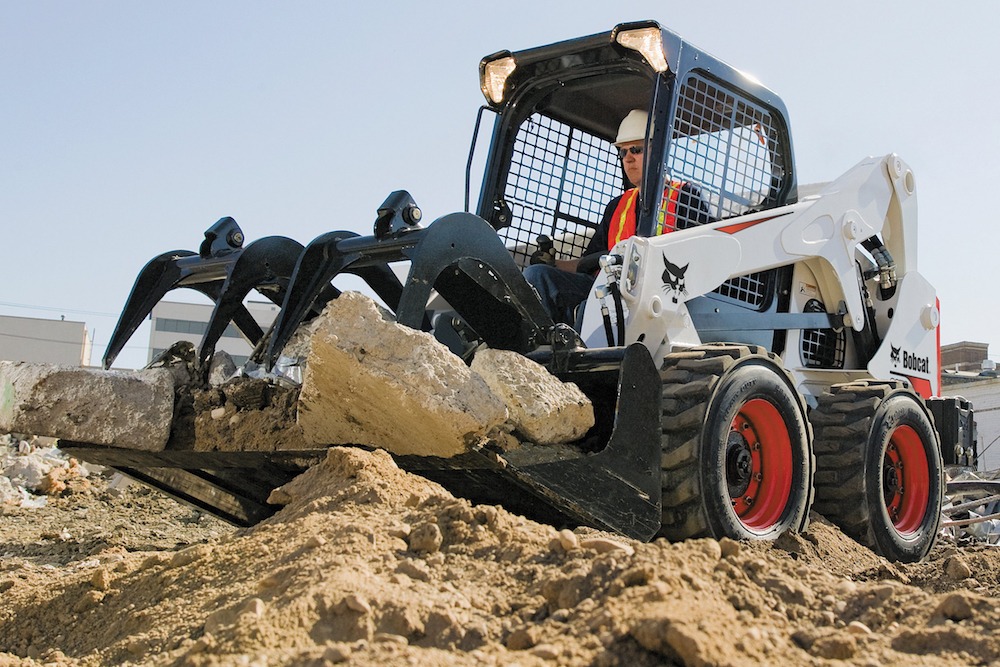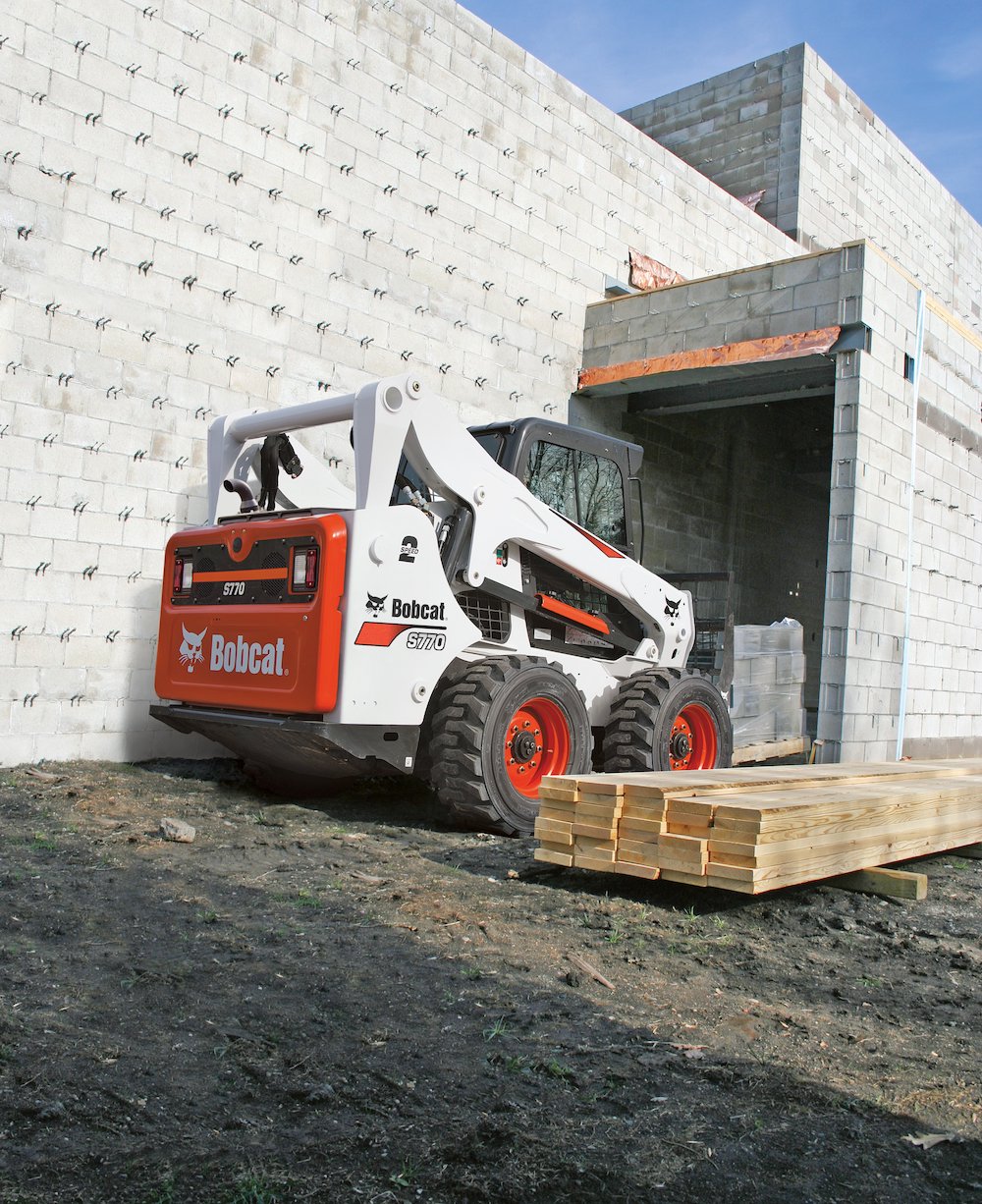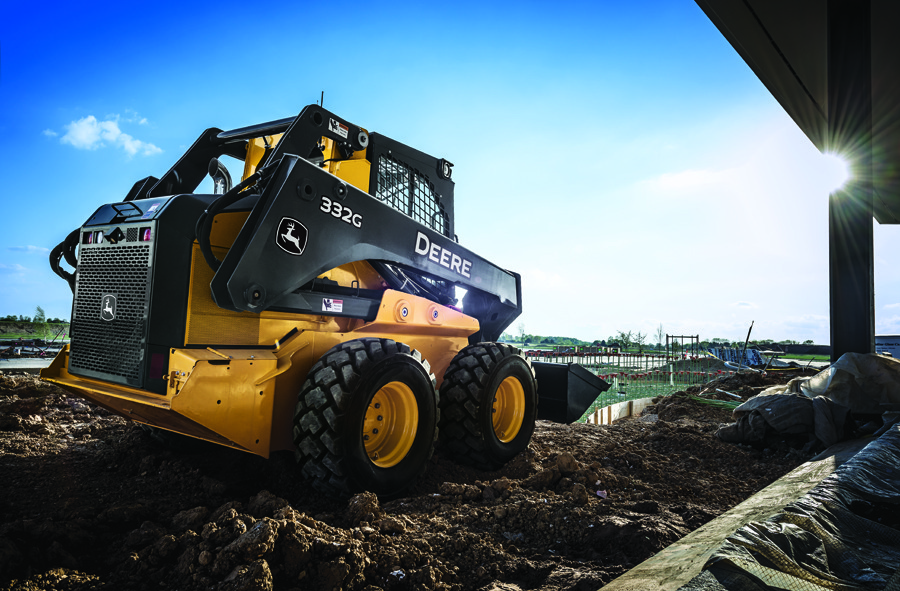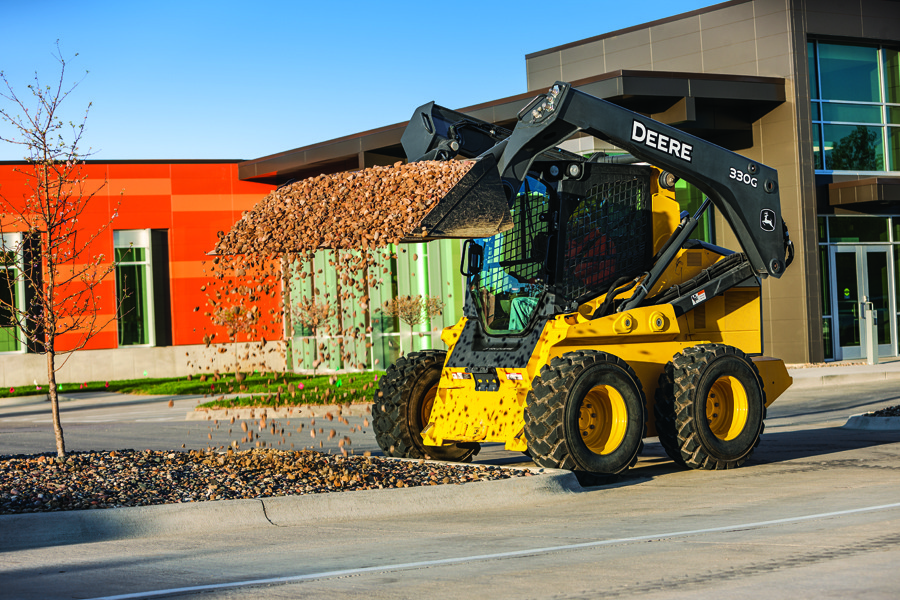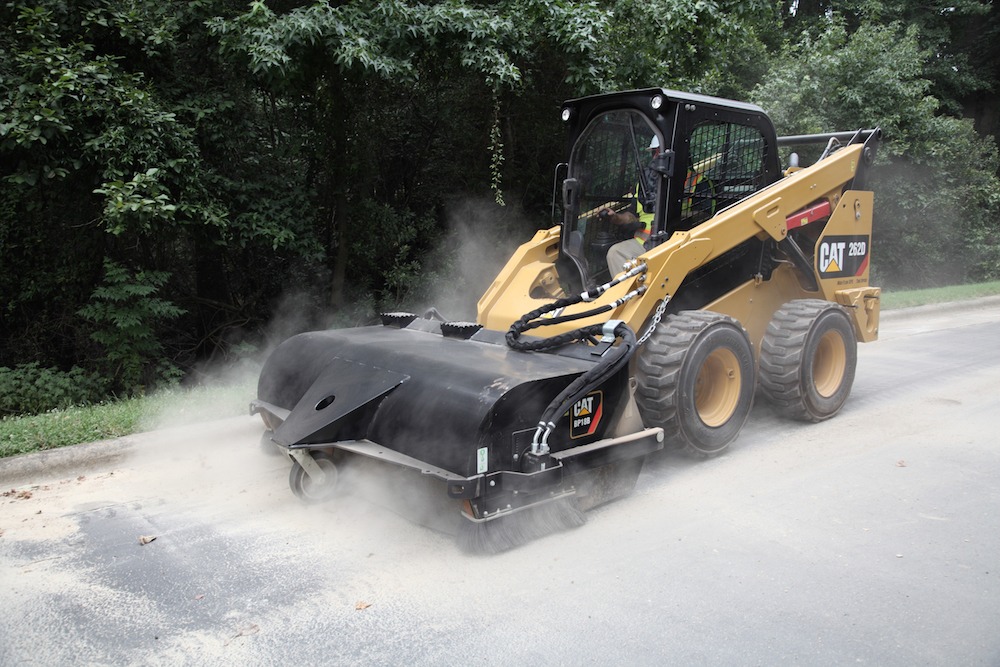Manufacturers are offering many new enhancements to skid-steer loaders to make the jobs of mason contractors much easier – and potentially more profitable for the bottom line.
A skid-steer loader is a compact piece of equipment with four wheels, in which the left-side drive wheels and the right-side drive wheels can move independently of each other at different speeds — causing the machine to turn or “skid” within its wheelbase, says Jason Archbold, marketing manager at Bobcat Co. in West Fargo, N.D. A skid-steer loader has two lift arms connected to the machine with the ability to utilize different attachments such as buckets, pallet forks and hydraulic breakers.
“Skid-steer loaders are a type of compact equipment and they are well suited for jobsites where space may be limited,” Archbold says. “These loaders can be paired up with many different attachments making them a very versatile machine.”
A hydraulic breaker attachment can be used to break up old concrete or masonry in preparation for a new job, a grapple can be used to remove this debris and an angle broom or sweeper can clean a space of debris and dust, he says. Pallet fork attachments can unload and move pallets of masonry brick and other materials. A concrete mixer attachment allows an operator to mix, transport and dump concrete faster than a traditional stand-alone mixer with controls inside the cab.
Skid-steer loaders come in many different weight classes, but the main differentiation is the type of lift arm paths available — radius and vertical, Archbold says. Radius-lift-path machines are best for projects that require material to be dumped over walls, backfill or load flatbed trucks. This economical configuration lifts the bucket or attachment in an arc pattern, providing greater reach at mid-range heights compared to a vertical-lift-path range of motion.
Vertical-lift-path machines are ideal when placing pallets of blocks or sod, or dumping into high-sided trucks, he says. On vertical-lift-path loaders, the load is raised straight up, closer to the machine. An operator can safely lift more than an identical radius-lift-path machine. Since there is more reach at full lift height, the machine can dump material into the center of the truck – or keep the loader farther away from the truck.
Bobcat’s compact equipment line includes skid steer, all-wheel steer and compact track loaders; compact excavators; mini track loaders; VersaHANDLER® telescopic tool carriers; utility vehicles; Toolcat™ utility work machines and attachments. For Bobcat® skid-steer loaders, several new technological developments have been added to the machines in recent years which provide operators better comfort and performance.
Automatic ride control, launched on the M2-Series loaders, allows operators to use a switch inside the cab to toggle between auto and off, Archbold says. When auto mode is selected, the system will work at any travel speed. The automatic ride control function is activated by detecting increased hydraulic lift arm pressure when the loader is carrying material. It will automatically deactivate when hydraulic lift arm pressure is reduced – such as grading when there is no load in a bucket.
The reversing fan option, also launched for use with M2-Series loaders, allows operators to temporarily reverse the cooling fan direction to blow dust and small debris from the radiator and rear screens, he says. The reversing fan option helps minimize downtime and can reduce the cooling area cleaning frequency. Contractors should take precautionary measures when working with skid steers, Archbold says.
“Knowing how a machine works, realizing a machine’s capabilities and limitations, and exercising appropriate behavior inside and around the machine can help minimize the risk of accidents,” he says.
Skid-steer loaders are very popular because they can fit into really tight areas that big construction equipment cannot, and they’re typically easier to operate, says Gregg Zupancic, skid-steer product marketing manager at John Deere Construction & Forestry in Moline, Ill., a division that offers skid steers, as well as dozers, excavating equipment, backhoes and other products.
“With almost no training a guy can get in and operate one without any real special licenses or a short amount of practice to run a skid steer,” Zupancic says. “They’re typically under 10,000 pounds, so they’re easy to transport from job site to job site. Because they’re smaller, they’re less expensive for contractors to purchase than larger equipment that is used for earth moving and lifting heavy loads.”
There are sizes of skid steers, including very small ones, which can have a machine width from four to six feet, he says. These loaders are especially good for constructing sidewalks. Mason contractors typically use larger skid steers, which can handle heavier loads of concrete, brick or other masonry materials.
“At John Deere we’re very interested in technologies that make loaders easier to operate,” Zupancic says. “For example, if an operator didn’t want the skid steer boom to travel up as fast as it possibly can at full speed, we created perimeters in the machine to slow the speed down. Or if an operator is lifting a pallet of expensive stone and they don’t want to accidentally dump it, we have features that will automatically level the bucket as the operator lifts the load in the air.”
John Deere’s loaders also feature perimeters for speeding responsiveness, in which the operator can set perimeters to be very aggressive or for higher productivity, he says. Another perimeter enables operators to select the operating pattern for better control.
“Typically all manufacturers will provide videos and training materials to give to our dealers, and the dealers will provide those to the company or contractor based on what would be required,” Zupancic says. “There may be certain regulations at a city level that require training before operating a skid steer.”
John Deere incorporates a great deal of safety gear inside the skid steer, including seatbelts and pull-down lap safety bars inside the skid steers, he says. The cabs is designed for rollover protection — if the machine would tip for whatever reason, the cab will protect the operator as the side screens are made out of steel. There are lights and hazard buttons, and the machines can be also equipped with warning beacons.
Volvo Construction Equipment North America is a Shippensburg, Penn.-based unit of Volvo Group. Volvo CE products include a full range of excavators and attachments, wheel loaders, articulated haulers, pipelayers, road equipment, skid-steer loaders and compact track loaders. The manufacturer offers wheeled and tracked skid steers, or compact track loaders, says Kevin Scotese, Volve CE product manager.
“Wheeled skid steers are great for jobs on hard surfaces, such as rock, concrete or asphalt,” Scotese says. “Tracked machines are good for jobs on surfaces such as dirt, grass or turf, offering a higher level of stability, as well as less ground disturbance.”
Volve CE’s vertical lift models raise the arm straight up, whereas its radial lift models arc out shortly after the arm starts to raise until it reaches full height, he says.“Generally, vertical lift machines are best for truck loading,” Scotese says. “The extra reach due to the arc gives radial lift a slight edge when unloading pallets and reaching across a truck if unloading from only one side. Radial lift machines are best for applications with ground-engaging attachments.”
Volvo CE skid steers include numerous features to alleviate safety concerns, he says. Due to the single loader tower arm design, cab access is easier and safer, and visibility is increased. To allay durability concerns, the single arm on Volvo CE machines is guaranteed for life.
“Operators enter and exit the cab through a large, wide-opening side cab door,” Scotese says. “This eliminates the need for operators to climb onto and over the bucket or attachment, which many times can be muddy, wet or slippery. On wheeled skid steers, a bolt-on non-slip step under the door increases safe entry and exit of the cab.”
Skid steers may be used in a variety of ways on masonry job sites, including site prep work such as moving earth and grading, as well as removing existing masonry work with demolition attachments, he says. Using a fork attachment, skid steers can also move pallets of building supplies.
Contractors should be aware of the capabilities of the machine in relation to job requirements, Scotese says. They should always check the specifications of the machine against the application for which the machine is needed, to make sure that the machine can handle the task or that the contractor has the right attachments for the job.
“For example, if you will be moving pallets of stone, you will want to make sure that the rated operating capacity of the machine is enough for the weight of the pallets to be transported and that you acquire the appropriate fork for the job,” he says. “Attention to detail and knowledge of the job is important, and will reduce wear and tear on the machine.”
As with any machine, knowing the capabilities and capacities of the equipment being used is necessary for safety while on the job site, Scotese says. For instance, with skid steers, the operator will want to know the tipping load of the machine, which is how much the skid steer can safely pick up without tipping the machine. Rated operating capacity is typically 50 percent of the tipping load.
If there is a need to travel on the road with a skid steer, take the necessary precaution of using the proper warning lights or an escort vehicle, he says.
Caterpillar Inc. has offered skid steer loader products from its Sanford, N.C. facility since 1999, says Kevin Coleman, product expert. Last year, the facility reached a significant milestone when the 250,000th machine manufactured at the facility rolled off the assembly line.
“I truly feel a skid steer loader is the most versatile piece of equipment Caterpillar offers,” Coleman says. “It can do almost any task when properly matched with one of the multitude of work tool attachments. These could include non-powered work tools such as buckets, for digging, grading or carrying material, or forks for handling palletized materials. However, utilizing the auxiliary hydraulics provided on the machine, more complex hydro-mechanical work tools can be used, such as brooms, trenchers, hammers, milling heads, augers, soil prep tools or grapple buckets.”
At a basic level, all skid steers are of similar design with four rubber tires, he says. Where they differentiate from one another is in lifting path – radial or vertical; size, both in physical dimensions – length, width and height; and in their rated operating capacity. The rated operating capacity of a skid steer is determined via an industry standard rating. This rating helps the consumer to size the machine correctly for the application, as well as compare models of similar size across multiple manufacturers.
A very popular variant of the skid steer is the compact track loader, a skid steer with a rubber track undercarriage in place of the rubber tires found on a traditional skid steer, Coleman says.
“The compact track loader has advantages in that it provides lower ground pressure and ground disturbance than a traditional skid steer due to the rubber track providing a larger contact patch through which to distribute the machines’ weight,” he says. “The compact track loader also provides a larger lifting base, giving it more stability for lifting heavier loads, compared to a similarly sized skid steer. A compact track loader can be advantageous for masonry customers that often handle the heavy pallets of brick, block or pavers in soft or uneven underfoot conditions.”
For increased versatility, compact track loader can be fitted with other work tool attachments such as a mixing bucket, Coleman says. The Cat mixing bucket allows for dry and wet material mixing which can be found on many masonry job sites.
“This hydraulically driven attachment is designed to quickly and effectively mix materials from the cab of the machine, he says. “Equipped with a hydraulically operated chute door to eliminate the need to exit the cab to open the bucket, the fully incorporated mix can be dispersed around the job site at the touch of a button, allowing work to be completed in difficult to access areas, improving productivity and saving on transportation costs.”
No certifications or licenses are needed to operate a skid steer — however each employer or job site may have a specific policy regarding the required training in order to use a piece of heavy equipment, Coleman says.
Originally an agricultural company manufacturing threshing machines, CASE was established 1842 and has been in business for 175 years. Since its inception, the company has become one of the cornerstone manufacturers of skid steers for decades, John Dotto, Brand Marketing Manager of CASE Construction Equipment explains.
“There’s not a lot that skid steers don’t do — they are among the most versatile machines available today for earthmoving and construction work due to the application flexibility made possible by a wide range of attachments,” Dotto confirms. The base model of a skid steer is a platform that allows a contractor to do their work, the more attachments they have the more they will be able to do.
One thing’s for certain if contractors have skid-steers on a jobsite, it will simplify tasks that bigger machines can’t access easily. Similar to the little engine that could, skid-steers can do just about anything you’d like with the proper attachment and guidance.
